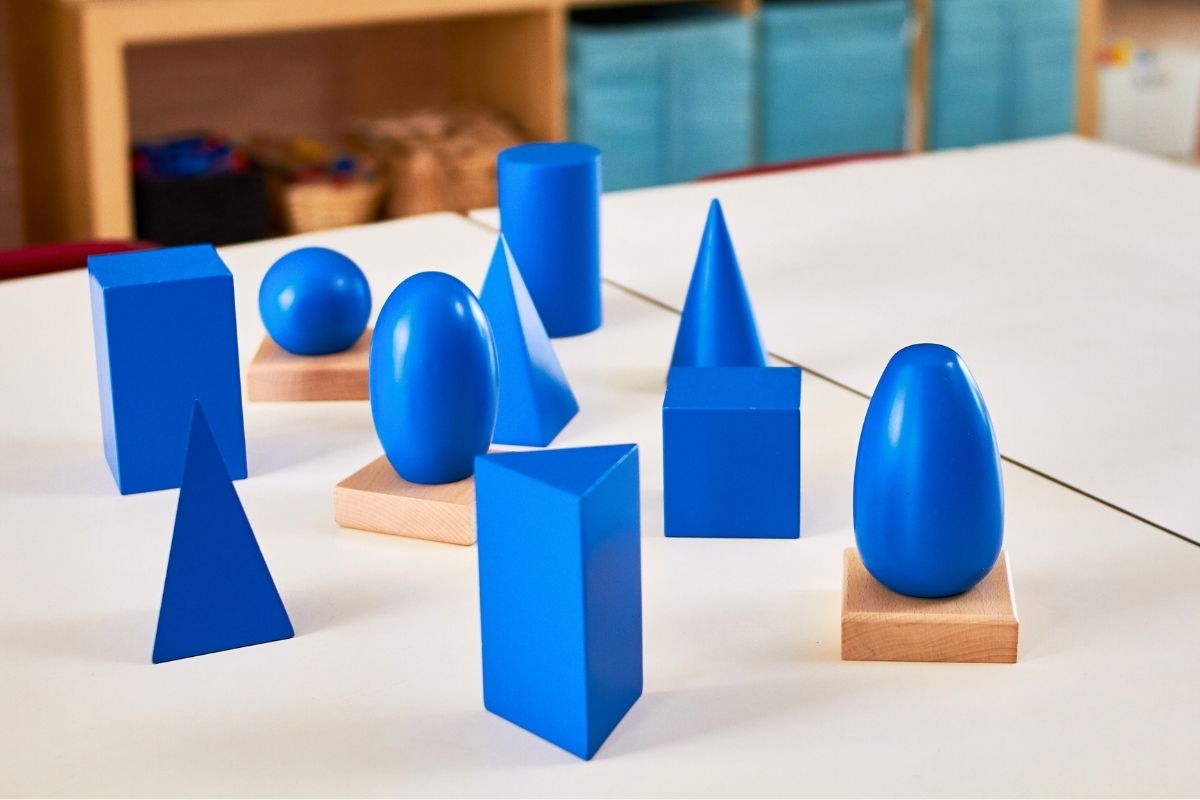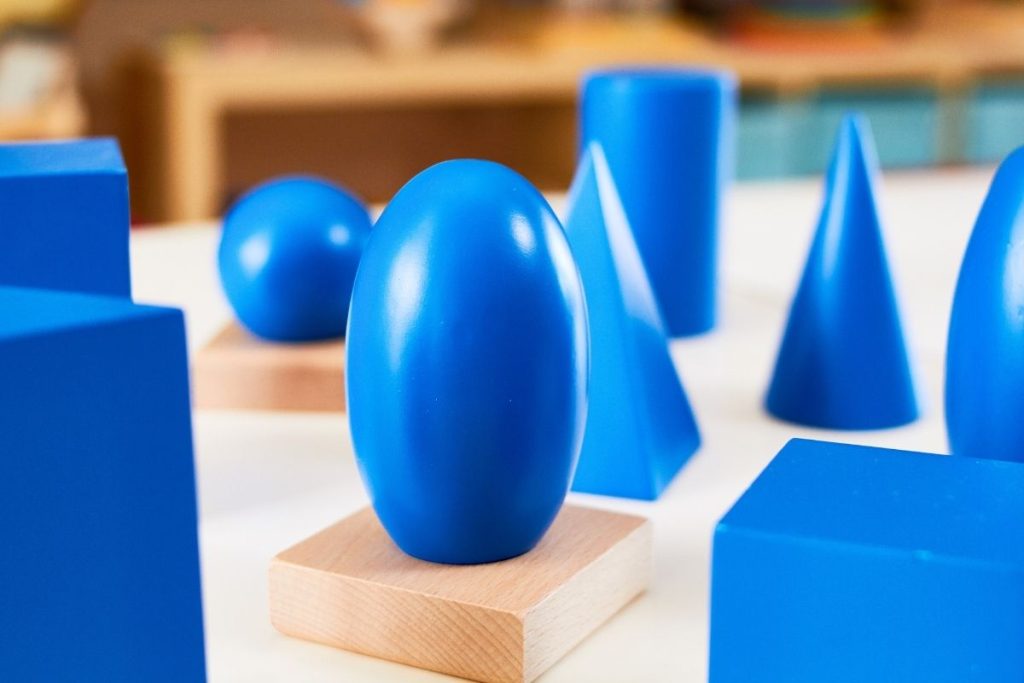Geometry plays a crucial role in children’s intellectual development and understanding of their surroundings. Geometric solids Montessori materials are an excellent gateway into this fascinating journey, using educational tools that stimulate kids’ stereognostic sense, perception, and interaction with shapes through touch.
Demystifying the Stereognostic Sense
The stereognostic sense is a child’s ability to recognize objects and forms by feeling them without relying on visual cues. This skill develops naturally as kids interact with various textures, shapes, and sizes. The Montessori method famously utilizes unique tools like geometric solids to enhance this perceptual capacity and foster a deeper connection with one’s tangible environment.
Unlocking a Universe of Shapes with Montessori Geometric Solids Materials
The Montessori approach has always emphasized the importance of tactile learning, allowing children to touch, feel, and manipulate objects as they learn. Geometric solids, in particular, play a pivotal role in this hands-on learning experience. These three-dimensional figures are not just mere toys but are powerful educational tools that introduce children to the world of geometry in a tangible manner. By interacting with these shapes, children can grasp complex geometric concepts that might be challenging to understand through mere visual aids or theoretical explanations.
Connecting Touch and Understanding
When working with geometric solids, children focus on sensing proportions and spatial relationships through tactile exploration. Identifying these three-dimensional figures only by the feel helps develop an essential mental picture of the world. This activity prepares young ones for more advanced recognition tasks later in their lives – swiftly differentiating circles from squares, cones from cylinders, and so on.
Precise Specifications for Effective Learning
Montessori geometric solids are meticulously crafted from premium, eco-friendly wood. Every edge is smoothed down to a rounded finish, ensuring safety and comfort for young learners. Each figure is designed with the same balance and weight as their basic counterparts, ensuring a true representation of the shapes. Furthermore, every solid produced adheres to uniform specifications, ensuring consistency, durability, and perfect adaptability for teaching methods.
A set of geometric solids typically includes ten essential shapes:
| Geometric Solid | Description |
|---|---|
| Cone | A solid with a circular base and a pointed top |
| Cube | A solid with six equal square faces |
| Cylinder | A solid with two parallel circular bases |
| Ellipsoid | A solid resembling a flattened sphere |
| Ovoid | A solid resembling a stretched or elongated sphere |
| Rectangular Prism (Cuboid) | A solid with six rectangular faces |
| Sphere | A round solid with all points equidistant from its center |
| Square Pyramid | A solid with a square base and four triangular faces |
| Triangular Prism | A solid with two parallel triangular bases and three rectangular faces |
| Triangular Pyramid (Tetrahedron) | A solid with a triangular base and three triangular faces meeting at a point |
These shapes are fundamental in the Montessori curriculum, serving as essential tools to help children grasp three-dimensional forms and their unique properties. Through hands-on interaction with these solids, students not only become familiar with their names but also acquire a tactile understanding of geometry. This foundational knowledge sets the stage for them to delve into more advanced mathematical concepts in the future.
Exploring Curved-sided Solids
Though geometric solids generally stick with the basics, innovative teachers have integrated curved-sided shapes into their repertoire, exposing children to spheres, ovoids, and ellipsoids at an early age. This approach encourages students to perceive dimensions in more complex objects, stretching their imagination and spatial awareness capabilities beyond regular polygons.
Mindful Lessons Using Geometric Solids
The journey to understanding geometric concepts requires engaging and dynamic activities in which students interact with various shapes, designs, and tangible forms. Listed below are some tried-and-tested exercises using geometric solids Montessori materials:
-
Mystery Bag Activity
A favored way to develop young learners’ stereognostic sense is by placing the geometric solids in a mystery bag and having the child identify each shape without seeing it. This activity promotes blind touch and deepens the mental correlations between objects and their specific attributes.
-
Matching with Bases
Encourage children to match each geometric solid to its respective base or shape drawn on paper. Begin by focusing on only a few shapes initially, and then gradually add more complexity as curiosity and understanding grow.
-
Tracing Outlines
For older, more dexterous children, tracing outlines of geometric solids onto paper presents an opportunity to refine visual-spatial representation skills. Start with simpler forms like cubes and spheres before delving into intricate structures like pyramids and tetrahedrons.
Enhancing Education Beyond Geometric Solids Montessori Materials
While working with geometric solids is undoubtedly rewarding in developing the child’s stereognostic sense and perception abilities, Montessori education encompasses other fantastic tools designed for holistic growth. As children advance through various learning stages, consider:
- The Pink Tower: Ten cubes decreasing in size, teaching balance and weight perception.
- The Brown Stairs (or Broad Stairs) : Ten prisms of the same length but varying width, aiding in width discrimination.
- The Long Red Rods: Ten rods of increasing length, helping with size differentiation.
- The Knobbed Cylinders: Four boxes of ten cylinders, assisting in height analysis.
During this journey, remember that touching, feeling, and perceiving are fundamental aspects for shaping young minds. The introduction and consistent engagement with geometric solids Montessori materials support kids in building their knowledge about three-dimensional objects, ultimately expanding horizons for future intellectual endeavors.





